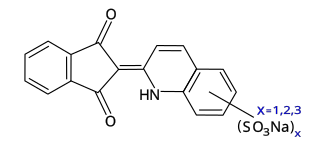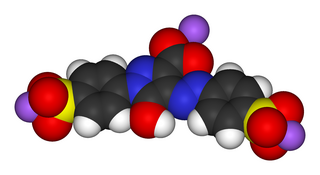
Aspartame is an artificial non-saccharide sweetener 200 times sweeter than sucrose and is commonly used as a sugar substitute in foods and beverages. It is a methyl ester of the aspartic acid/phenylalanine dipeptide with brand names NutraSweet, Equal, and Canderel. Aspartame was approved by the US Food and Drug Administration (FDA) in 1974, and then again in 1981, after approval was revoked in 1980.

Food additives are substances added to food to preserve flavor or enhance taste, appearance, or other sensory qualities. Some additives have been used for centuries as part of an effort to preserve food, for example vinegar (pickling), salt (salting), smoke (smoking), sugar (crystallization), etc. This allows for longer-lasting foods such as bacon, sweets or wines. With the advent of ultra-processed foods in the second half of the twentieth century, many additives have been introduced, of both natural and artificial origin. Food additives also include substances that may be introduced to food indirectly in the manufacturing process, through packaging, or during storage or transport.

Food coloring, or color additive, is any dye, pigment, or substance that imparts color when it is added to food or drink. They can be supplied as liquids, powders, gels, or pastes. Food coloring is used in both commercial food production and domestic cooking. Food colorants are also used in a variety of non-food applications, including cosmetics, pharmaceuticals, home craft projects, and medical devices. Colorings may be natural or artificial/synthetic.

Quinoline Yellow WS is a mixture of organic compounds derived from the dye Quinoline Yellow SS. Owing to the presence of sulfonate groups, the WS dyes are water-soluble (WS). It is a mixture of disulfonates (principally), monosulfonates and trisulfonates of 2-(2-quinolyl)indan-1,3-dione with a maximum absorption wavelength of 416 nm.p. 119
Carmine – also called cochineal, cochineal extract, crimson lake, or carmine lake – is a pigment of a bright-red color obtained from the aluminium complex derived from carminic acid. Specific code names for the pigment include natural red 4, C.I. 75470, or E120. Carmine is also a general term for a particularly deep-red color.

Tartrazine is a synthetic lemon yellow azo dye primarily used as a food coloring. It is also known as E number E102, C.I. 19140, FD&C Yellow 5, Yellow 5 Lake, Acid Yellow 23, Food Yellow 4, and trisodium 1-(4-sulfonatophenyl)-4-(4-sulfonatophenylazo)-5-pyrazolone-3-carboxylate.

Sunset yellow FCF is a petroleum-derived orange azo dye with a pH dependent maximum absorption at about 480 nm at pH 1 and 443 nm at pH 13 with a shoulder at 500 nm. When added to foods sold in the United States it is known as FD&C Yellow 6; when sold in Europe, it is denoted by E Number E110.

Dexmethylphenidate, sold under the brand name Focalin among others, is a potent central nervous system (CNS) stimulant used to treat attention deficit hyperactivity disorder (ADHD) in those over the age of five years. It is taken by mouth. The immediate release formulation lasts up to five hours while the extended release formulation lasts up to twelve hours. It is the more active enantiomer of methylphenidate.

Sodium benzoate also known as benzoate of soda is the sodium salt of benzoic acid, widely used as a food preservative (with an E number of E211) and a pickling agent. It appears as a white crystalline chemical with the formula C6H5COONa.

Brilliant blue FCF is a synthetic organic compound used primarily as a blue colorant for processed foods, medications, dietary supplements, and cosmetics. It is classified as a triarylmethane dye and is known under various names, such as FD&C Blue No. 1 or acid blue 9. It is denoted by E number E133 and has a color index of 42090. It has the appearance of a blue powder and is soluble in water and glycerol, with a maximum absorption at about 628 nanometers. It is one of the oldest FDA-approved color additives and is generally considered nontoxic and safe.

Erythrosine, also known as Red No. 3, is an organoiodine compound, specifically a derivative of fluorone. It is a pink dye which is primarily used for food coloring. It is the disodium salt of 2,4,5,7-tetraiodofluorescein. Its maximum absorbance is at 530 nm in an aqueous solution, and it is subject to photodegradation.

Ponceau 4R is a synthetic colourant that may be used as a food colouring. It is denoted by E Number E124. Its chemical name is 1-(4-sulfo-1-napthylazo)-2-napthol-6,8-disulfonic acid, trisodium salt. Ponceau is the generic name for a family of azo dyes.

Allura Red AC is a red azo dye that goes by several names, including FD&C Red 40. It is used as a food dye and has the E number E129.

Amaranth, FD&C Red No. 2, E123, C.I. Food Red 9, Acid Red 27, Azorubin S, or C.I. 16185 is a modified red azo dye used as a food dye and to color cosmetics. The name was taken from amaranth grain, a plant distinguished by its red color and edible protein-rich seeds.

Scarlet GN, or C.I. Food Red 2, FD&C Red No. 4, or C.I. 14815 is a red azo dye once used as a food dye. As a food additive, it has the E number E125. It is usually used as a disodium salt.
The Feingold diet is an elimination diet initially devised by Benjamin Feingold following research in the 1970s that appeared to link food additives with hyperactivity; by eliminating these additives and various foods the diet was supposed to alleviate the condition.

Guanfacine, sold under the brand name Tenex (immediate-release) and Intuniv (extended-release) among others, is an oral alpha-2a agonist medication used to treat attention deficit hyperactivity disorder (ADHD) and high blood pressure. Guanfacine is FDA-approved for monotherapy treatment of ADHD, as well as being used for augmentation of other treatments, such as stimulants. Guanfacine is also used off-label to treat tic disorders, anxiety disorders, and post-traumatic stress disorder (PTSD).
Attention deficit hyperactivity disorder management options are evidence-based practices with established treatment efficacy for ADHD.

Solriamfetol, sold under the brand name Sunosi, is a wakefulness-promoting medication used in the treatment of excessive sleepiness related to narcolepsy and sleep apnea. It is taken by mouth.

Serdexmethylphenidate/dexmethylphenidate, sold under the brand name Azstarys, is a fixed-dose combination medication containing serdexmethylphenidate, a prodrug of dexmethylphenidate, and dexmethylphenidate, a d-threo enantiomer of racemic methylphenidate, which is used to treat attention deficit hyperactivity disorder (ADHD) in people aged six years and older.


















